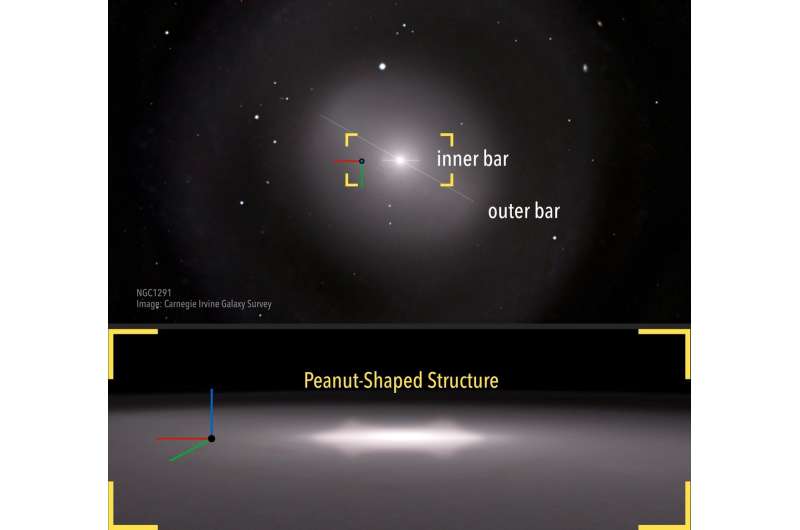Galaxies like Russian dolls

Jairo Méndez Abreu and Adriana de Lorenzo-Cáceres, researchers at the Instituto de Astrofísica de Canarias (IAC), have discovered a peanut-shaped structure in the inner bar of a double-barred galaxy close to the Milky Way. Structures of this type, previously detected only in outer bars, are useful tracers of the evolution of the galaxies.
The complexity of the shapes and structures found within spiral galaxies has fascinated astronomers for decades, and is a key to understanding their evolution. One example of this complexity is the galaxy NGC 1291. The French astronomer Gerard de Vaucouleurs discovered a system in this galaxy in which there are two stellar bars, and identified a pattern that he termed "lens-bar-nucleus," which is repeated in the outer and the inner part of the galaxy. This structure is basic for understanding the internal evolution of the galaxies, and how they fuel the supermassive black holes at their centres.
In this same galaxy, it has been shown for the first time that there is a peanut-shaped structure in the inner bar. These structures are caused by vertical motions of the stars in the bar, and they are named for their boxy peanut shape when the galaxy is observed sideways on. However, until now, this type of structure had been detected only in the outer bars of double-barred galaxies, or in individual bars such as that in the Milky Way.
The observations have been performed using the MUSE spectrograph on the Very Large Telescope (VLT) at the European Southern Observatory (ESO), and show that peanut-shaped structures can also form inside inner bars. "This is important," explains Jairo Méndez Abreu, an IAC researcher, "because it shows that some galaxies are like Russian dolls, with internal structures the same as external structures except for their smaller size." These results also show that the inner bar is following the same evolutionary path as the outer bar.
"The presence of an X-shaped structure in the inner bar of NGC 1291 implies that these can be stable structures which last for thousands of millions of years," explains Adriana de Lorenzo-Cáceres, also a researcher at the IAC and the second author of the article. This means that they have a long time in which to take gas into the centre of the galaxy, and supports the idea that they "feed" supermassive black holes, although this has not been confirmed by observations.
More information: J Méndez-Abreu et al. Inner bars also buckle. The MUSE TIMER view of the double-barred galaxy NGC 1291, Monthly Notices of the Royal Astronomical Society: Letters (2018). DOI: 10.1093/mnrasl/sly196
Journal information: Monthly Notices of the Royal Astronomical Society Letters
Provided by Instituto de Astrofísica de Canarias





















